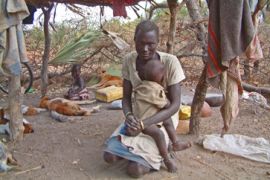Drought and conflict in south Sudan
Poverty, malnutrition and disease soar as tensions over water resources increase.

 |
| Martin was caught in the crossfire between rival tribes over control of water resources and had to have his leg amputated beneath the knee due to improper medical care [Islamic Relief] |
The people of southern Sudan have become used to conflict for the control of land and resources after decades of civil war, a fragile peace agreement, and the widespread use of arms.
But even by south Sudan’s standards the internal conflict that is plaguing the region is unprecedented, and it seems that the situation will only get worse.
There are currently in excess of 350,000 people who have been displaced by inter-ethnic conflict in south Sudan, largely due to growing tensions over scarce resources such as water, as well as an increase in cattle raiding.
Martin Ater was waiting to collect water from the only hand-pump in his village near Rualbet in Warrap, when a fight broke out between two different tribes. Both were trying to get to get water for their families and their cattle.
“I was caught in between as the two groups shot at each other. I’m not sure who shot me but six other people were also injured. In this area I think about 40 people have died in this way, fighting over water,” said Martin.
Amputated
Martin was shot several times in the shins. He was taken to a clinic in Warrap but his injuries were serious and they were unable to treat him. He then had to borrow money to get to a hospital in Wau. The damage done by the bullets was so great that he had to have his leg amputated below the knee.
Back in Martin’s village, tensions continued to escalate between the two tribes and not long after the initial fight the rival group came to his village, stole the community’s cattle and burned their mud huts to the ground.
With no home, no cattle and his crops destroyed, Martin lost everything he had. He is now living under a tree with his pregnant wife, relying on any food that the local community can spare.
“There has been no rain here for the last year so no-one has been able to grow any crops. This is the worst drought I have ever known and many people have died or migrated because they have no food or water,” explained Martin.
“Usually when things are hard you can borrow animals from a better off family member, but this year no-one has anything to give.”
Water shortages
Water has always been a problem in Warrap, and although Islamic Relief has constructed more than 80 hand-pumps with another 60 due to be completed early this year, the needs are still vast.
This crisis has been exacerbated by the drought that has affected more than 20 million people across east Africa. In south Sudan, the conflict and cattle raids are making the situation even more difficult for the 40 per cent of the population who are struggling to feed themselves.
The full affects of the food crisis can be seen in remote villages such as Kirik, not far from Warrap town, which has also been subject to cattle raids by neighbouring tribes that left over 50 people dead and two whole villages displaced. The two hand-pumps in the village were also destroyed leaving people with no source of clean water until Islamic Relief restored them.
In these communities cattle are a person’s bank account allowing them to purchase food, clothing and even to get married. The loss of these precious commodities has been made more severe by the fact that people now have no reserves of food to fall back on.
Weak harvest
Kirik is a village of 13,000 people and hundreds of traditional mud huts or tukuls, situated in parched land two hours from Warrap. In the small market on the edge of the village there is little for sale and what is available is beyond the reach of most of the community. Here a sack of sorghum, the staple food in the area, is on sale for over $90.
The high prices reflect the fact that south Sudan has been barely able to harvest any crops this year and has had to import from neighbouring countries such as Uganda and Kenya.
The chief of Kirik village, Pacien Deng, said: “People have only been able to cultivate a small amount of land this year because of the drought and the conflict. Last year each family produced about six sacks of sorghum and ten sacks of groundnuts. This year they have grown virtually nothing.”
Unable to afford these enormously high prices, the people of Kirik have been eating just one meal a day, often consisting of berries picked from the trees or even boiled grass. This is a coping mechanism used by communities during the hunger season before the next harvest, but they have had to start eating these wild foods months before they normally would.
Malnutrition soars
Across south Sudan rates of malnutrition are soaring, with around one-third of people already malnourished. In Kirik as in other villages in Warrap, many children are visibly malnourished, while diseases such as diarrhoea and malaria are claiming the lives of many young children already weakened by a lack of food.
With the next rains not due until June, without intervention the situation is expected to get much worse.
“The little food that we have in store has almost run out. We have few animals left that we can sell or slaughter, and those we have are getting weaker,” said Pacien.
“If you come to our village in a few weeks time then I’m afraid you may find us dead.”
Helen Mould is the media coordinator for Islamic Relief in south Sudan.